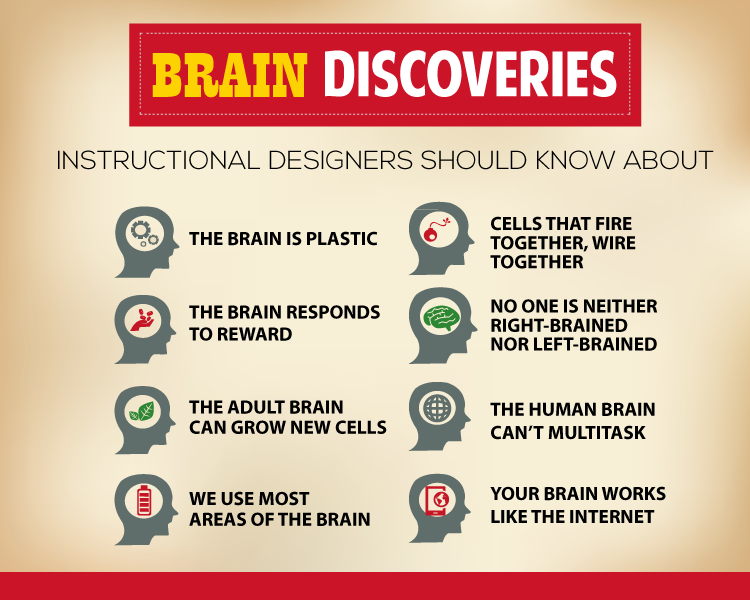The human brain is the seat of learning. We know about this already, right? But we actually know very little about the brain. Even the latest brain research discoveries comprise only the tip of an iceberg. Still, every new discovery is an important piece of the brain puzzle and an indispensable guide to creating effective eLearning material. Understanding how the brain works definitely influences your student's learning readiness. Educators, instructional designers, and eLearning professionals in general ought to be interested in the brain because after all, they teach brains!

1. The brain is plastic.
Have you heard the story of a constantly changing brain? It’s our very own human brain and we have a lot to do with it. In fact, what we do changes our “plastic” brain. It’s a concept usually referred to as “neuroplasticity.” It’s often summed up in the phrase “neurons that fire together wire together” and scientists think of it as the brain’s extraordinary way of adapting.
Neuroplasticity has weighty consequences, especially when it comes to learning. For one, it means that the brain can be improved and continue to adapt and learn through life, even after middle age and during old age. This also means that the brain can learn better, that the human potential for learning is limitless.
Help your students realize their potential by focusing on their basic thinking skills, attention most importantly. Remember, neuroplasticity requires focused attention.
2. The brain responds to reward due to several factors.
The relationship between reward and learning is never simple. Recent discoveries by neuroscientists, in fact, revealed just the opposite. Our brain’s response to rewards is influenced by many factors and chief among them are context and individual differences. Every learner, after all, has his or her unique expectations.
In the context of reinforcement learning, for instance, the individual learner’s reward system responds to prediction error, which is the difference between the result an individual expects from his or her action and the outcome he or she actually gets. Prediction error lets us learn which specific action has the most promising outcome.
3. The adult brain CAN grow new cells.
In the past, scientists used to believe that the human brain changes very little after it matures. But that’s considered out of date. The brain’s plastic, remember? Recent studies revealed that it does grow new cells in the hippocampus. What’s more, these new cells take on functional roles and interact with existing cells.
4. Learners use most areas of the brain.
This runs contrary to the myth that individuals are using only 5 to 10 percent of their brain. There’s no proof of this. Neuroscientists and neurologists have already presented evidence that refute this “10 percent” myth. There is, for example, the scan of the human brain, which is always active no matter what we’re doing.
5. Cells that fire together, wire together.
This phrase explains the “use-it-or-lose-it” phenomenon. Or to put it simply, if you want to retain new information, you have to use it constantly or else lose it. When you stop practicing a new skill or a new language, for instance, your brain will eventually prune or eliminate certain pathways. You’ll eventually lose a new skill unless you keep on practicing.
Help students retain new information. Let them understand that “only perfect practice makes perfect.” This means two things. One, that they need to practice constantly. And two, that it has to be a “perfect” practice. Learners have to take practice seriously so that they can build a stronger, more efficient and more hard-wired connections in the brain.
6. No one is neither right-brained nor left-brained.
You cannot categorize learners into these camps. This idea of “brained-ness” is not only a myth, it also doesn’t help students especially when you stereotyped them either as right-brained or left-brained.
While it’s true that some brain functions occur on either part of the brain, researchers have confirmed that personality traits have nothing to do with which side of their brain learners use more.
7. The human brain CAN'T multitask.
Think you can open five Facebook chat windows, eat lunch and talk to your friend on the phone, all at the same time? Think again. Your brain, our human brain, cannot focus on all these tasks at once. Multitasking simply splits the brain or frantically switches from chatting to eating to talking.
The multitasking brain, in fact, is significantly inefficient in filtering irrelevant information and simply doesn’t work. So if you want students to get the right results, strongly discourage them from multitasking.
8. Your brain works a lot like the Internet.
This is a very recent study which exposes the basic principles of brain function. Researchers studied brain activity using a functional magnetic resonance imaging (fMRI) and found that the brain works like a complex interacting network, like the Internet. It depends on nodes to efficiently pass on information from place to place. This runs counter to the neurological assumption that the brain works in a hierarchical order.









